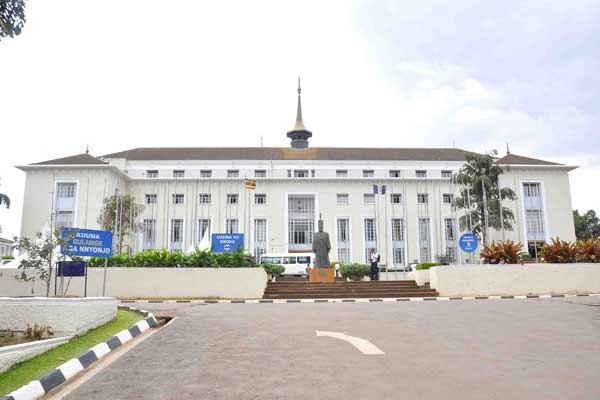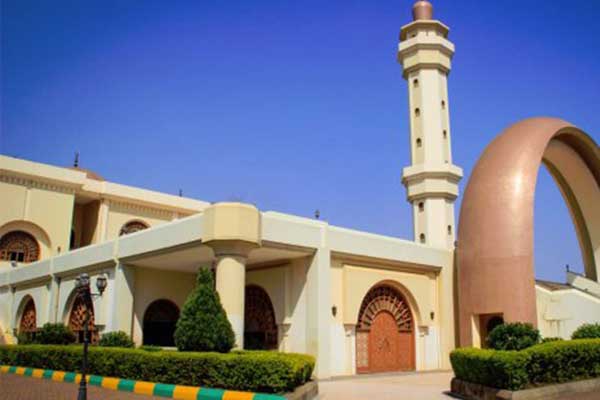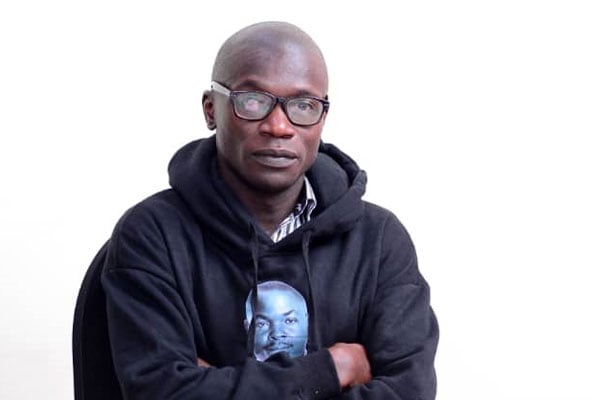How Buganda wields power over Christian, Muslim faiths

Bulange Mengo, the seat of Buganda Kingdom. PHOTO / FILE
What you need to know:
At least 144 years have passed since foreign religion was introduced to the Kabaka’s court. But the relationship between the seat of the Kabaka at Mengo and the three dominant religions, namely the Anglican, Catholic and Muslim faiths, have remained frictional.But Mengo still holds sway over all of them writes, Derrick Kiyonga.
If directions are to be used, Namirembe hill, which seats the headquarters of Anglican faith in Uganda, lies north-west of Mengo town, which hosts the official palace of Buganda Kingdom.
Yet to the west of Mengo, is Rubaga hill, which hosts Saint Mary’s Cathedral Rubaga, popularly referred to as Rubaga Cathedral, the parent cathedral of the Roman Catholic Archdiocese of Kampala, the oldest Roman Catholic diocese in Uganda.
The Mengo establishment is welded to two of Uganda’s powerful religions. And no one can talk about the two churches without Mengo coming into the picture.

Rubaga Cathedral, the seat of the Roman Catholic Archdiocese of Kampala. Photo / File
Whilst the land on which the behemoth St Paul Cathedral Namirembe was constructed is said to have been donated by Kabaka Muteesa I Mukaabya Walugembe, on the other hand, where Rubaga Cathedral is, was Muteesa I’s palace before he shifted to Mengo hill after the place had been razed by a mysterious fire.
His son Mwanga, in 1889, gave up the land his father had abandoned to the French Catholic missionaries, commonly known as the White Fathers, who were laying ground for the budding Catholic church in the country.
First missionaries in Uganda
Anglican missionaries Shergold Smith and C. T. Wilson of the Church Missionary Society (CMS) were the pioneer European missionaries to Uganda when they arrived at Muteesa I’s court in 1877 while the Catholic missionaries Simeon Lourdel famously known as Mapeera and brother Delmas Amansi arrived at the same court in 1879.
Historians say the order in which these two sets of missionaries arrived has come to define the relationship the two religions have had with Mengo.
“Mengo has always been a Protestant [Anglican] establishment and it has not changed up to now despite having a Katikkiro [Charles Peter Mayiga], who is a Catholic and the previous ones being Catholic too,” Mr Mwambustya Ndebesa, a political – historian at Makerere university, says.
“I don’t think the Roman Catholic church has ever had organic roots within Mengo. It has been an Anglican establishment from colonial times and of course, all kings and Katikkiros (prime ministers) were protestant except [Mulwanyamuli Ssemwogerere being the first Catholic Katikkiro].”
He adds: ‘ I don’t know how many royals are Catholics. There are some royals who are Catholics but those of the ruling family I think they are Anglicans. All the descendants of Muteesa I I think they are Anglicans.”
Jonathan L Earle, in his book, Colonial Buganda and the End of the Empire, says it is not without reason then, that the capital of Anglicanism in Buganda was called Namirembe, the place of peace.
“The archaeology of colonial power was enshrined in the public architecture of Protestantism. In Luganda, the etymology of Namirembe was politically instructive. Its meaning derived from –member, and simply referred to a ‘period; era; epoch; century’ In the form of a proverb it was used to suggest that ‘things come and go’ (emirembe ngalo), literally, ‘generations are fingers’,” Earle writes.
Earle says when the controversial 1900 Buganda Agreement was crafted, the Anglicans inevitably got the better of the deal, taking the lion’s share of the 11 counties of Bulemeezi, Bugerere, Buruli, Busiro, Ggomba, Kabula, Kooki, Kyaddondo, Kyaggwe, Ssese, and Singo. He says the Catholics were given the eight counties of Buddu, Busujju, Buvuma, Buwekula, Mawogola, Mawokota Buyaga and Bugangaizi were returned to Bunyoro following the controversial 1964 referendum.
Despite taking a firm foothold in the royal family, the Anglicans relationship with Mengo has not always been a bed of roses.
In his article tilted, A history of Christianity in Uganda, Kevin Ward writes that Muteesa I and later Mwanga, his crabby successor, came to regard Anglicans with suspicion owing to their connections to the British government, which was expanding its colonial empire.
“Moreover the Arabs at the court increasingly denounced the missionaries as agents of European imperialism,” Ward says.
“In 1882, the British actually bombarded Alexandria in Egypt and this was the prelude to a gradual takeover of Egypt. The CMS missionaries protested they had non-connection with their government, but they could not at times resist pointing out the might of the British Empire. In the event the authorities were right to be suspicious because by the 1890s, the Anglicans or CMS missionaries were openly advocating a British takeover of Uganda; though this is not to say that they had been conscious agents of imperialism in the 1880s.”

Namirembe Cathedral, the headquarters of the Anglican Church. PHOTO / FILE
Muteesa I, a master of the game, decided to allow all religions to flourish without personally accepting any to wield power and keep neutrality. But once he died, Mwanga wasn’t able to replicate what his father had done.
In 1885, Anglican Bishop James Hannington, 37, was murdered, on the orders of Mwanga just because he had come from Busoga, which was considered to be Buganda’s “back- door.”
Mwanga’s slaughter against Christianity continued when two weeks after the murder of Hannington, Joseph Mukasa Balikuddembe was murdered. His sin? Criticising the Kabaka for murdering the Anglican prelate.
In 1886, large extermination of Christians, of both Catholics and Anglicans took place at Namugongo, the traditional execution site.
“The immediate cause of the killings was the Kabaka’s anger at the disobedience of his Christian pages, in particular their refusal to indulge in homosexual practices,” Ward insists.
Faiths unite
By 1887, the Muslims, Protestants and Catholics had got hold of arms and started consolidating themselves as regiments called Abapere.
Initially, Ward says Mwanga first encouraged and promoted these groups as a way of countering the older generation of chiefs but when they became too influential, his frail attempt to get rid of them instead triggered a coup.
Mwanga was ousted in 1888 by united forces of Muslims, Anglicans and Catholics, who also couldn’t agree on how to govern and soon turned guns on each other, sparking off what’s called religious wars in Buganda.
“The Muslims preceded to establish a Muslim state. They circumcised their Kabaka Kalema and called him ‘Sheikh’. They envisaged a radical reordering of society along Islamic lines,” Ward writes.
With the help of British military officer and colonial administrator Captain Fredrick Lugard, the British Imperial East African Company (IBEAC) ousted the Muslims and reinstated Kabaka Mwanga.
Again, the Anglicans and Catholics coalition couldn’t last long as they bickered over political offices and when open warfare broke out in 1892, Lugard’s intervention swung the pendulum in favour of the Anglicans with his Maxim gun routing the Catholics.
When IBEAC went broke, the British had no option but to declare Uganda their protectorate with Anglican Bishop Alfred Robert Tucker said to have done a lot of clandestine campaigns in Britain to ensure that this turns into a reality.
But Mwanga’s attempt to regain independence was easily thwarted by the British, and he was banished to Seychelles -an archipelago in the Indian Ocean- where he was christened as Anglican and he was baptised Daniel or Danieri.
“But was his choice of the baptismal name Daniel, a final act of defiance –a reference to his confinement in the lions’ den of his captor?” Ward asks.
With Mwanga out, the weight of leadership fell on the shoulders of Kabaka Daudi Chwa, and the signing of the 1900 Buganda agreement, which buttressed the British takeover.
In terms of religion, the agreement consolidated the dominant position of the Anglican oligarchy under Apollo Kaggwa, the Katikkiro and of the regents of Kabaka Chwa II.
Islam was relegated to an underprivileged minority and Muslims were given one county: Butambala. Though Islam had been relegated into the background, it was the first “foreign” religion to take root in Buganda in 1844, nearly 33 years before the arrival of Christianity.
Islam introduced
It was introduced by Zanzibari missionary-trader Ahmed bin Ibrahim during the rule of Kabaka Kalema Ssuna II, Muteesa I’s father.
When Ssuuna II passed on in 1856, Muteesa I took over, and according to Ward between 1867 and 1876, he patronised Islam. “He learnt some Arabic, attended and even led prayers in a mosque built at the Lubiri [ palace],” Ward wrote.
But he says Muteesa had what he calls a genuine intellectual curiosity in the teachings of Islam but his concern mainly was largerly with matters of the state and he saw Islam as a tool to enhance his power.
Soon came the Egyptian Muslims who criticised many of Muteesa I’s ways, including the Kabaka’s leading of Friday prayers despite being uncircumcised.
The Egyptians, according to Ward, asked the Baganda Musilms to reject meat slaughtered by Muteesa I’s butchers, and to the Kabaka, this amounted crossing the rubicon.
“The subsequent defiance of the young Bagalagala (pages) led to the execution of some 100 Musilms at Namugongo, one of the traditional execution sites of Buganda,” Ward writes.
Muteesa I had a young brother called Nuhu Mbogo Kyabasinga, who is now revered by Muslims as the pillar on which Islam stands today in entire Uganda.
Mbogo, according to several accounts, reviewed for this article was only nine years old when Islam was first introduced at Kabaka Ssuuna II’s court.
In 1888, when the Muslim insurrectionists dislodged Mwanga, they replaced him with Muteesa’s eldest son Kiweewa Mutebi I, who was ousted within only six weeks after he refused to get circumcised.
Kiweewa was replaced by his brother Nuhu Kalema, who rebelled against Ganda traditional norms and got circumcised.
Following the outbreak of the 1888 religious wars, Kalema led the Muslim army but because they could not match the superior weapons employed by the British colonialists, who fought alongside the Christians, the Muslims were forced to withdraw to Kijungute, where Kalema died of smallpox in 1890.
“While Buganda’s Muslim community maintained central power in Buganda’s political landscape, superior weaponry allowed Christian chiefs and colonisers to secure political power in the 1890s, resulting in political marginalisation of the Ganda Muslims,” wrote Earle, in a dissertation entitled, “Political theologies in late colonial Buganda,” he submitted at Selwyn College, the University of Cambridge.
Upon the death of Kalema, Mbogo took over as the ostensible head of the Muslim community in Buganda, which group also affirmed him as “Kabaka”.
In 1894, locking out Mbogo, IBEACO declared Buganda a British Protectorate, and Lugard swayed Mbogo and Kalema’s surviving son to return to Buganda from Kijungute.
But Islam has continued to weather its minority status in Buganda and thrive.
Lugard, according to different accounts, deceitfully had Mbogo arrested, which provoked anger from the Muslims who afterwards started rallying to regain political supremacy.
With support from Nubian and Egyptian soldiers, they planned a revolt. Lugard responded by exiling Mbogo to Zanzibar between 1893 and June 25, 1895.
Mbogo eventually returned following pressure from the Muslims but the Anglican oligarchy ensured that at the writing of the 1900 Buganda Agreement, Mbogo was locked out of the race to the Buganda throne when ascendance to the throne was limited to offspring of Muteesa I.

Gaddafi National Mosque in Old Kampala. PHOTO / FILE
Nonetheless, the Buganda Agreement had something for Muslims as 24 square miles of land at Kibuli, Kawempe and Nakawa were given to Mbogo and his adherents and he in turn dedicated the land to the expansion of Islam.
“Available Lukiiko records from 1894 to 1918 indicate the extent to which Mbogo and Muslim devotees were required to negotiate the construction of mosques within predominantly Christian counties,” Earle writes.
“Unlike Ganda church planters, Muslim leaders were required to inform the Lukiiko of the exact locations where mosques were going to be constructed. In consequence, Muslim leaders were constantly engaged in a debate over the acquisition of land for the construction of mosques.”
When Mbogo died in March 1921, Prince Badru Kakungulu Wasajja, his 14-year-old son, succeeded him.
When Kakugulu passed on in 1991, he was succeeded by Prince Kassim Nakibinge, who leads the Kibuli Muslim faction and it’s recognised by Mengo whereas the central government, officially, recognises the Old Kampala faction.
Both colonial and post-colonial Uganda created a headache for the Anglicans who believed that they were part and parcel of the Mengo establishment.
This split has torn the Muslim faith right in the middle across the country.
When Ericka Sabiiti, from Ankole, was appointed the first native Archbishop of Uganda in 1967, replacing Briton Leslie Brown, the Baganda Anglicans refused him to access St Paul’s cathedral in Namirembe.
The Baganda congregants led by one Edita Nassozi Musolooza [now buried at the cathedral] closed the main entrance contending that a non-Muganda could not lead ‘their cathedral’ which is sitting on the land donated by Muteesa I.
This impelled the formation of the Kampala Diocese with a seat at All Saints Cathedral, Nakasero, where the Archbishop of the Church of Uganda leads services despite having his official home on Namirembe hill, adjacent to the cathedral where he should pray from.
“There was conflict within the Anglican church over a non-Muganda leading Namirembe until the 1970s during Idi Amin’s [ administration] a bishop’s conference was held at the Nile Conference Centre to resolve the fate of the Archbishop of Uganda,” Mr Ndebesa explains.
“The rest of the bishops tried to convince the Baganda that Namirembe has always been the seat of the archbishop but the Baganda weren’t having any of that. They refused to agree and Idi Amin was aware of what was going on. He locked them in the conference centre. He told them nobody is going home. He will bring them food. He locked them there.”
He adds: “They were there throughout the night until they agreed that let them create a seat for the Archbishop of Uganda. So that’s how they created that small enclave of Kampala Diocese with its seat at All Saints Nakasero. From that time, the archbishop doesn’t sit in Namirembe, although his office and residence are Namirembe.”
The tribal tensions came to the fore in 2015 when Henry Luke Orombi, who is from West Nile and had retired as archbishop, claimed during the 2015 new year eve prayers how Namirembe Cathedral had demons that manifest themselves in form of black cats.
Some interpreted this as an attack aimed at the Baganda clergy that dominate Namirembe.
Similarly, the animosity between the Catholic Church and the Mengo establishment went beyond independence but for some reason, the two parties would reconcile.
With independence arriving fast, the Mengo establishment and its supporters wanted the Kabaka’s position in the post-colonial Buganda secured.
They pushed for Buganda’s secession from Uganda so that Edward Muteesa, the Kabaka at the time, having succeeded his father Chwa, would remain their king and also be the President.
Muteesa’s followers weren’t ready to listen to any dissenting views: It was either their way or no other. Muteesa had banked on a deal he struck with Apollo Milton Obote, an Anglican, who wanted to be Uganda’s executive Prime Minister.
Catholic Archbishop Joseph Kiwanuka of Kampala Archdiocese opposed the marriage of convenience between Uganda’s Peoples Congress (UPC) and Kabaka Yekka (KY), both led by Anglicans.
This sparked off hostility between Muteesa and the Catholic prelate but still, Kiwanuka in 1961 wrote a famous or infamous letter attacking the Mengo establishment and its devotees.
Muteesa’s response was swift. He ordered the detention of Monsignor Joseph Ssebayigga, the Domestic Prelate Archpriest of Rubaga Cathedral.
Muteesa suspected that Ssebayigga and Cardinal Emmanuel Wamala had interpreted Kiwanuka’s letter from Luganda to English.
With Kiwanuka out of the country, Ssebayigga was arrested and taken to the palace for the Kabaka to personally question him.
Archbishop rejected
Archbishop Kiwanuka was one of the spiritual guardians of Muteesa following the death of Chwa in 1939 and when he returned to the country he went to attend Lukiiko at Mengo in that capacity.
But on arrival, Kiwanuka was met by taunts and jeers, forcing him to leave in protest only to find his Mercedes- Benz parked outside the Lukiiko vandalised by Mengo ruffians, who also poured salt in its radiator and engine organism.
Kiwanuka, according to historians, footed back from Bulange to Rubaga and vowed never to return to Buganda’s Lukiiko.
A promise he kept but as it is with many of these fights when the tempers had cooled, Muteesa sought reconciliation and he dispatched his emissary to Kiwanuka, asking for peace talks.
The two first met at Twekobbe, Kabaka’s official residence in Mengo and later at Rubaga for a ceasefire. They agreed not to fight again.
But Mengo’s disagreement with Rubaga can only be temporary. Indeed, when the central government troops attacked the Kabaka’s Mengo palace in 1966, it is the Catholics that led an operation that enabled him to flee to exile.
He first sought refuge at Rubaga.
By this time Kiwanuka had passed on but Ssebayigga, others affectionately welcomed the king before telephone contacts were made in Italian to a Catholic mission in Tanzania in case their telephone line were bugged.
From Rubaga, Kabaka Muteesa went to Tanzania before he crossed to Burundi and lastly flew to the UK where he died in 1969.
“Despite that,” Ndebesa says, “Mengo, just like Uganda, has always been an Anglican establishment. You can imagine of all presidents we have had, none is a Catholic yet they are the majority.”





